1988 PONTIAC FIERO light
[x] Cancel search: lightPage 1504 of 1825

POWER WINDOWS
TROUBLESHOOTING HINTS
s Try the following checks before doing the Sys-
tem Check.
1. If no windows operate, check the WDO Cir-
cuit Breaker by visual inspection.
2. If no windows operate, check that ground
6309 is clean and tight.
e Go to System Check for a guide to normal
operation.
e Go to System Diagnosis for diagnostic tests.
COMPONENT LOCNIOM Page-Figure
..................... ...... Fuse Block. Behind LH side
of IIP, below light switch. 201-10-A
................. ............. VVindow Motors In lower front corner of each door 201-18-A
................ ........ C238 (12 cavities) LH shroud, ahead of center access hole. 201-11-C
.......................... 6309 Below rear of console
.......................... S301. Crosscar harness, below LR front seat
SYSTEM DIAGNOSIS A: LH FRONT POWER WINDOW
e Do the tests listed for your symptom in the SWITCH TEST
Symptom Table below.
e Tests follow the Symptom Table.
SYSTEM CHECK SYMPTOM TABLE
* Use the System Check Table as a guide to
normal operation.
Refer to System Diagnosis for a list of symp-
toms and diagnostic steps.
SYSTEM CHECK TABLE
and DN from the
moothly, with no
EH Front Power
Window Switch
RH Front Window
RH Front Power
r Refer to System Diagnosis when a result
is not normal.
to splice S301 for an
open. If wire is OK,
perform tests A and
RH Front Power
Window does not Window Switch
CONNECTOR (Connected)
(A: LN FRONT POWER WINDOW
SWITCH TEST continued on next page)
Page 1505 of 1825
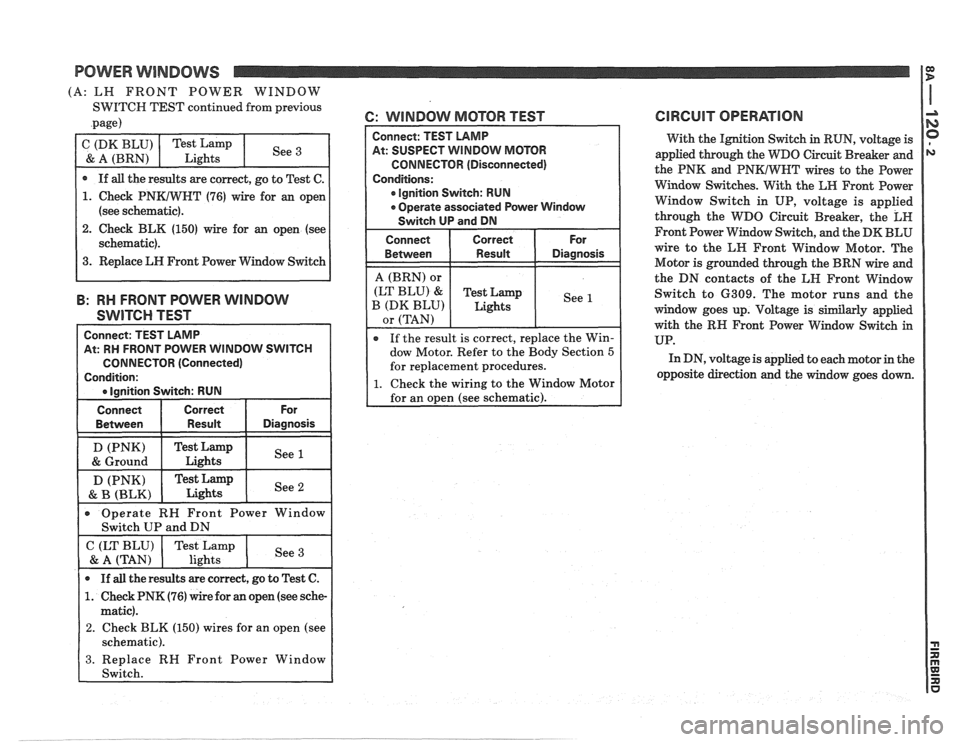
POWER WlNDOWS
(A: LH FRONT POWER WINDOW
SWITCH TEST continued from previous
.page) 6: WINDOW MOTOR TEST
. Check BLK (150) wire for an open (see
B: RH FRONT POWER WINDOW
SWITCH TEST
At: RM FRONT POWER WINDOW SWITCH
CONNECTOR (Connected)
I 0 lanition Switch: RUN I
s Ignition Switch: RUN
Operate associated Power Window
D (PNK) Test Lamp
& B (BLK) Lights See 2
0 Operate
RH Front Power Window
Switch UP and DN
C (LT BLU) ( Test Lamp ( See & A (TAN) lights
0 If all the results are correct, go to Test C.
1. Check PNK (76) wire for an open (see sche-
matic).
2. Check BLK (150) wires for an open (see
schematic).
3. Replace RN Front Power Window
Switch. With
the Ignition Switch in RUN, voltage is
applied through the
WDO Circuit Breaker and
the PNK and
PNKIWNT wires to the Power
Window Switches. With the LH Front Power
Window Switch in UP, voltage is applied
through the WDO Circuit Breaker, the
LN
Front Power Window Switch, and the DK BLU
wire to the LH Front Window Motor. The
Motor is grounded through the BRN wire and
the DN contacts of the LN Front Window
Switch to 6309. The motor runs and the
window goes up. Voltage is
similarly applied
with the RN Front Power Window Switch in
UP.
In DN, voltage is applied to each motor in the
opposite direction and the window goes down.
Page 1508 of 1825
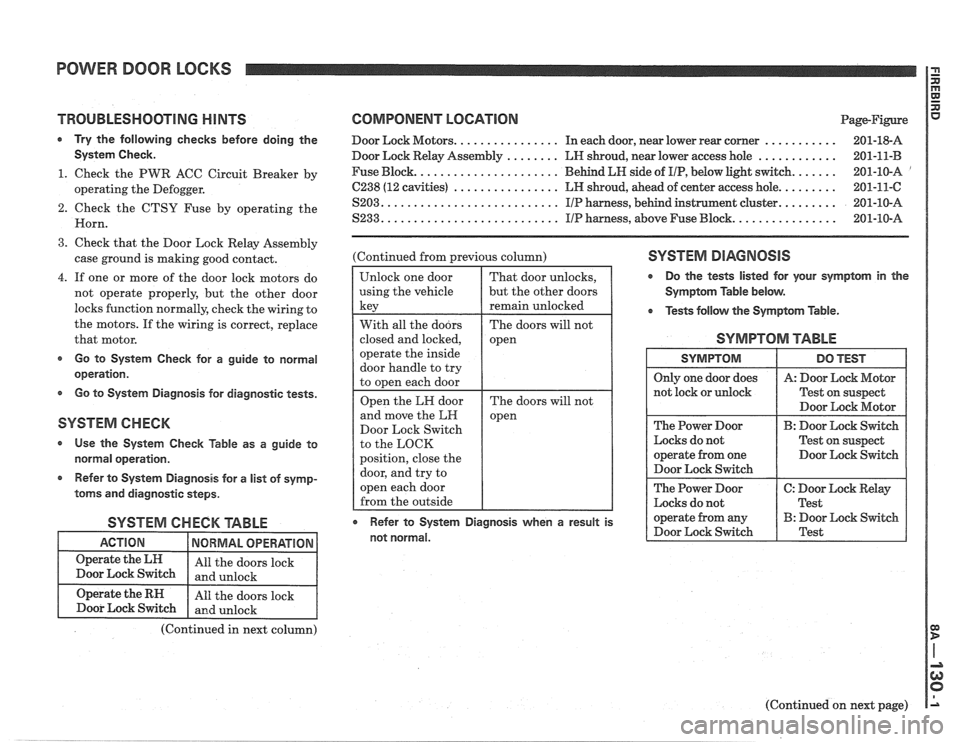
POWER DOOR LOCKS
TROUBLESHOOTING HINTS
Try the following checks before doing the
Systern Check.
1. Check the PWR ACC Circuit Breaker by
operating the Defogger.
2. Check the CTSY Fuse by operating the
Horn.
3. Check that the Door Lock Relay Assembly
case ground is making good contact.
4. If one or more of the door lock motors do
not operate properly, but the other door
locks function normally, check the wiring to
the motors. If the wiring is correct, replace
that motor.
s Go to System Check for a guide to normal
operation.
Go to System Diagnosis for diagnostic tests.
SYSTEM CHECK
Use the System Check Table as a guide to
normal operation.
r Refer to System Diagnosis for a list of symp-
toms and diagnostic steps.
SYSTEM CHECK TABLE
COMPONENT LOCATION Page-Rgure
Door Lock Motors. ............... In each door, near lower rear corner ........... 201-18-A
Door Lock Relay Assembly
........ LN shroud, near lower access hole ............ 201-11-B
Fuse Block. ..................... Behind LH side of IIP, below light switch. ...... 201-10-A '
C238 (12 cavities) ................ LH shroud, ahead of center access hole. ........ 201-11-C
S203. .......................... IIP harness, behind instrument cluster. ........ 201-10-A
S233. .......................... IIP harness, above Fuse Block. ............... 201-10-A
(Continued from previous column)
Door Lock Switch
to the LOCK
position, close the SYSTEM DIAGNOSIS
r Do the tests listed for your symptom in the
Symptom Table below.
Tests
follow the Symptom Table.
SYMPTOM TABLE
Test on suspect
Door Lock Motor
The Power Door
B: Door Lock Switch
Locks do not Test on suspect
operate from one Door Lock Switch
Door Lock Switch
The Power Door
C: Door Lock Relay
Locks do not
I Test
r Refer to System Diagnosis when a result is operate from any B: Door Lock Switch
not normal. Door
Lock Switch Test
(Continued in next column)
(Continued on next page)
Page 1509 of 1825
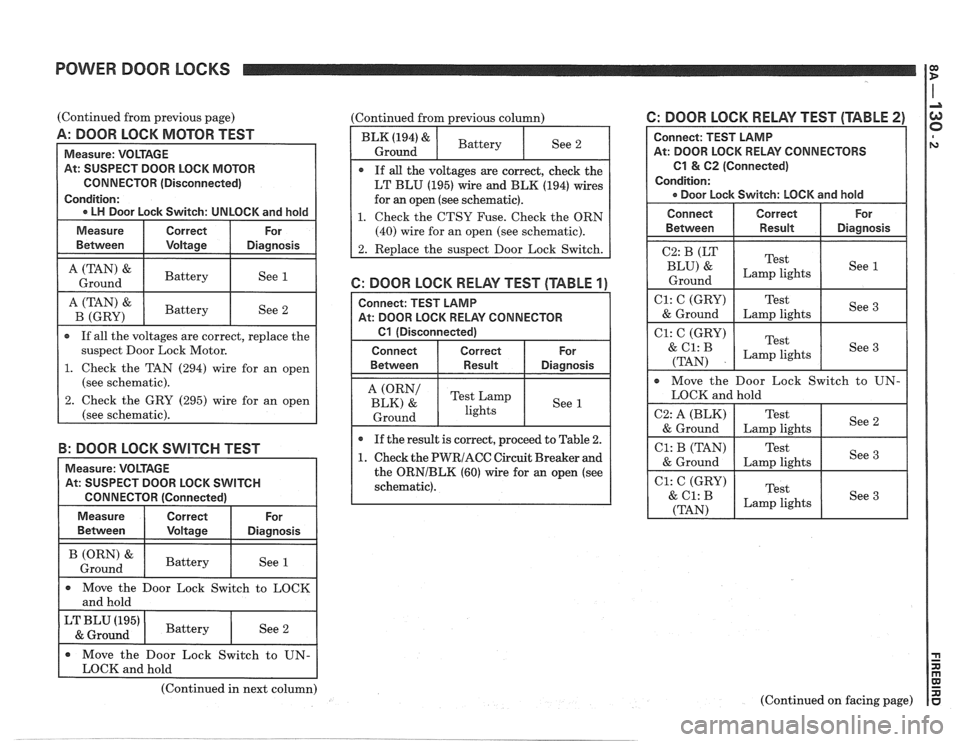
POWER DOOR LOCKS
IT
(Continued from previous page)
A: DOOR LOCK MOTOR TEST
At: SUSPECT DOOR LOCK MOTOR
CONNECTOR (Disconnected)
suspect Door Lock Motor.
1. Check the TAN (294) wire for an open
(see schematic).
2. Check the GRY (295) wire for an open
B: DOOR LOCK SWITCH TEST
(Continued from previous column)
See 2
If
all the voltages are correct, check the
LT BLU (195) wire and BLK (194) wires
for an open (see schematic).
1. Check the CTSU Fuse. Check the ORN
6: DOOR LOCK RELAY TEST [TABLE '11
Connect: TEST LAMP
At: DOOR LOCK RELAY CONNECTOR
61 (Disconnected)
A (ORN' Test Lamp
BLK) & See 1
1 Ground 1 lights
If the result is correct, proceed to Table 2.
1. Check the PWRIACC Circuit Breaker and
the
ORNIBLK (60) wire for an open (see
schematic).
(Continued in next column)
6: DOOR LOCK RELAY TEST (TABLE 2)
Connect: TEST LAMP
At: DOOR LOCK RELAY CONNECTORS
C1 & 62 (Connected)
Condition: Door Lock Switch: LOCK and hold
Move the Door Lock Switch to UN-
I LOCK and hold
C1: C (GRY)
Test See
3
(Continued on facing page)
Page 1512 of 1825
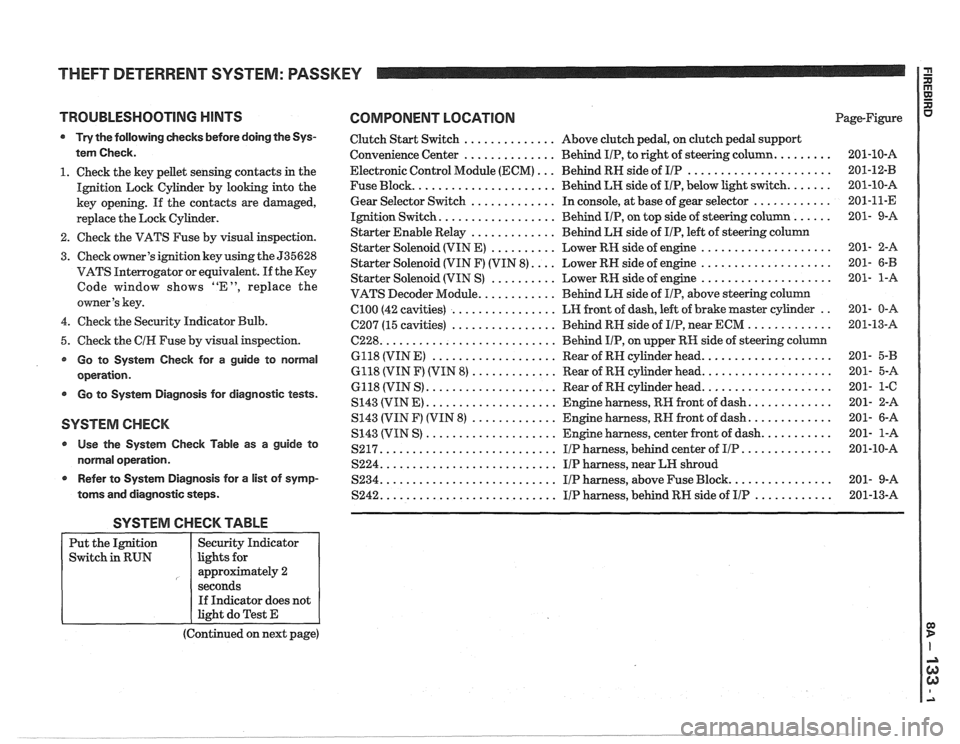
THEFT DETERRENT SYSTEM: PASSKEY I a
TROUBLESHOOTING HINTS COMPONENT LOCATION
Try the following checks before doing the Sys-
tem Check.
1. Check the key pellet sensing contacts in the
Ignition Lock Cylinder by looking into the
key opening. If the contacts are damaged,
replace the Lock Cylinder.
2. Check the VATS Fuse by visual inspection.
3. Check owner's ignition key using the 535628
VATS Interrogator or equivalent.
If the Key
Code window shows "E", replace the
owner's key.
4. Check the Security Indicator Bulb.
5. Check the
CIH Fuse by visual inspection.
Go to System Check for a guide to normal
operation.
Go to System Diagnosis for diagnostic tests.
SYSTEM CHECK
Use the System Check Table as a guide to
normal operation.
r Refer to System Diagnosis for a list of symp-
toms and diagnostic steps.
Clutch Start Switch .............. Above clutch pedal, on clutch pedal support
Convenience Center
.............. Behind IIP, to right of steering column. ........
Electronic Control Module (ECM) ... Behind RN side of IIP ......................
Fuse Block. ..................... Behind LH side of IIP, below light switch. ......
Gear Selector Switch ............. In console, at base of gear selector ............
Ignition Switch. ................. Behind IIP, on top side of steering column ......
Starter Enable Relay ............. Behind LH side of IIP, left of steering column
Starter Solenoid (VIN E)
.......... Lower RH side of engine ....................
Starter Solenoid (VIN F) (VIN 8). ... Lower RH side of engine ....................
Starter Solenoid (VIN S) .......... Lower RN side of engine ....................
VATS Decoder Module. ........... Behind LH side of IIP, above steering column
Cl00 (42 cavities) ................ LH front of dash, left of brake master cylinder ..
C207 (15 cavities) ................ Behind RN side of IIP, near ECM .............
6228. .......................... Behind IIP, on upper RH side of steering column
6118 (VIN
E) ................... Rear of RN cylinder head. ...................
6118 (VIN F) (VIN 8) ............. Rear of RH cylinder head. ...................
6118 (VIN S) .................... Rear of RN cylinder head. ...................
S143 (VIN E) .................... Engine harness, RR front of dash. ............
S143 (VIN F) (VIN 8) ............. Engine harness, RN front of dash. ............
S143 (VIN S) .................... Engine harness, center front of dash. ..........
S217. .......................... IIP harness, behind center of IIP. .............
S224. .......................... IIP harness, near LH shroud
S234. .......................... I/P harness, above Fuse Block. ...............
S242. .......................... IIP harness, behind RH side of IIP ............
SYSTEM CHECK TABLE
(Continued on next page)
Put
the Ignition
Switch in RUN
R aJ XI
Page-Figure u
Security Indicator
lights for
approximately 2
seconds If Indicator does not
light do Test E
Page 1516 of 1825
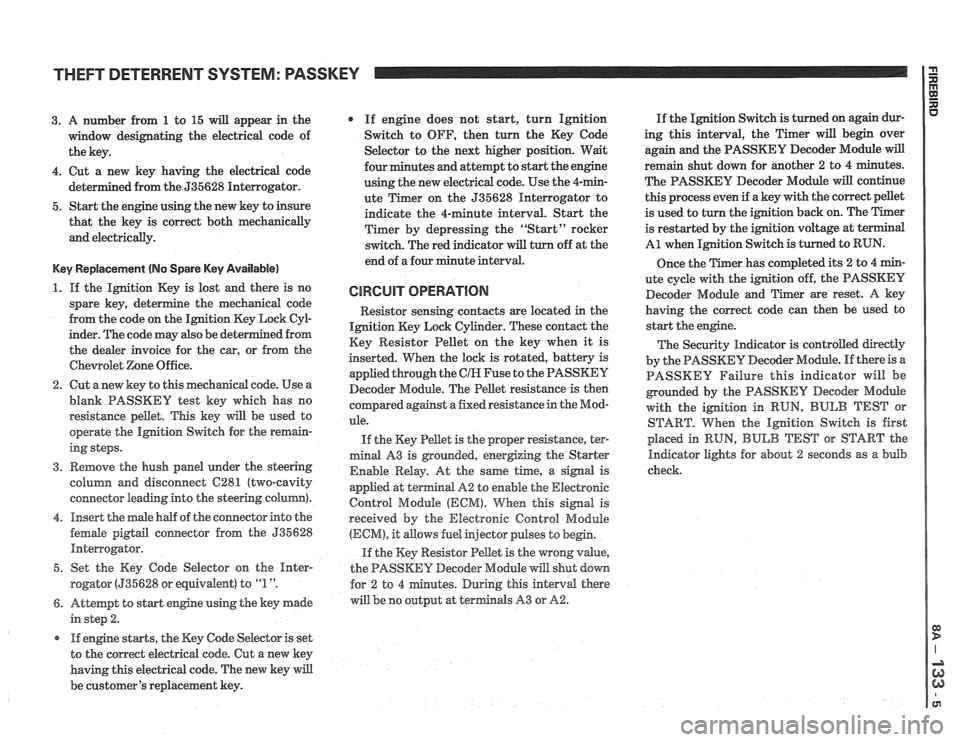
THEFT DETERRENT SYSTEM: PASSKEY
3. A number from 1 to 15 will appear in the
window designating the electrical code of
the key.
4. Cut a new key having the electrical code
ed from the 535628 Interrogator.
5. Start the engine using the new key to insure
that the key is correct both mechanically
and electrically.
Key Replacement (No Spare Key Available)
1. If the Ignition Key is lost and there is no
spare key, determine the mechanical code
from the code on the Ignition Key Lock
CyE
inder. The code may also be det
the dealer invoice for the car, or from the
Chewolet Zone Office.
2. Cut anew key to this mechanical code. Use a
blank PASSKEY test key which has no
resistance pellet. This key will be used to
operate the Ignition Switch for the remain-
ing steps.
3. Remove the hush panel under the steering
column and disconnect
C281 (two-cavity
connector leading into the steering column).
4. Insert the male half of the connector into the
female
pigtail connector from the 535628
Interrogator.
5. Set the Key Code Selector on the
Hnter-
rogator (535628 or equivalent) to "1 ".
6. Attempt to start engine using the key made
in step 2.
r If engine starts, the Key Code Selector is set
to the correct electrical code. Cut a new key
having this electrical code. The new key will
be customer's replacement key.
If engine does not start, turn Ignition
Switch to OFF, then turn the Key Code
Selector to the next higher position. Wait
four minutes and attempt to start the engine
using the new electrical code. Use the 4-min-
ute Timer on the 535628 Interrogator to
indicate the 4-minute interval. Start the
Timer by depressing the "Start" rocker
switch. The red indicator
will turn off at the
end of a four minute interval.
CIRCUIT OPERATION
Resistor senshg contacts are located in the
Ignition Key Lock Cylinder. These contact the
Key Resistor Pellet on the key when it is
inserted. When the lock is rotated, battery is
applied through the
CIH Fuse to the PASSKEY
Decoder Module. The Pellet resistance is then
colnpared against a fixed resistance in the Mod-
ule.
If the Key Pellet is the proper resistance, ter-
minal A3 is grounded, energizing the Starter
Enable Relay. At the
same time, a signal is
appfied at terminal A2 to enable the Electronic
Control Module
(ECM). When this signal is
received by the Electronic Control Module
(ECM), it allows fuel injector pulses to begin.
If the Key Resistor Pellet is the wrong
value,
the PASSKEY Decoder Module will shut down
tes. During this interval there
will be no output at terminals A3 or
A2.
If the Ignition Switch is turned on again dur-
ing this interval, the Timer will begin over
again and the PASSKEY Decoder Module
will
remain shut down for another 2 to 4 minutes.
The PASSKEY Decoder Module will continue
this process even if a key with the correct pellet
is used to turn the ignition back on. The Timer
is restarted by the ignition voltage at
t
A1 when Ignition Switch is turned to RUN.
Once the Timer has completed its
2 to 4 min-
ute cycle with the ignition off, the PASSKEY
Decoder Module and Timer are reset. A key
having the correct code can then be used to
start the engine.
The Security Indicator is controlled directly
by the PASSKEY Decoder Module. If there is a
PASSKEY Failure this indicator will be
grounded by the PASSKEY
Decoder Module
with the ignition in RUN,
BULB TEST or
START. When the Ignition Switch is first
placed in
RUN, BULB TEST or START the
Indicator lights for about 2 seconds as a bulb
check.
Page 1520 of 1825
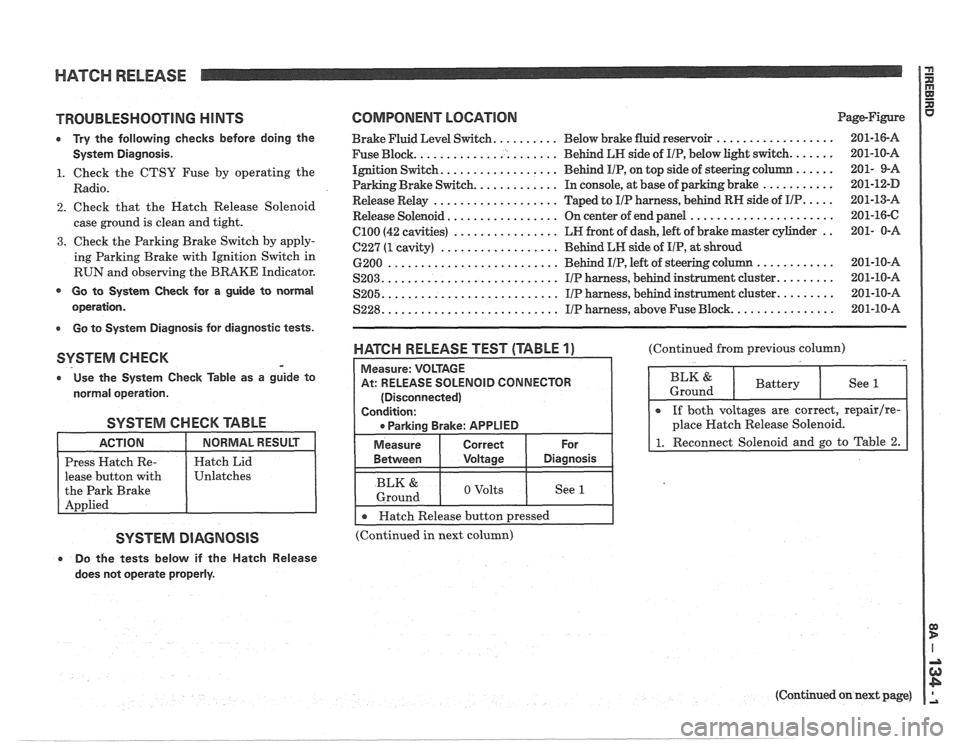
HATCH RELEASE P
E
TROUBLESHOOTING H lNTS
0 Try the following checks before doing the
System Diagnosis.
1. Check the CTSY Fuse by operating the
Radio.
2. Check that the Hatch Release Solenoid
case ground is clean and tight.
3. Check the Parking Brake Switch by apply-
ing Parking Brake with Ignition Switch in
RUN and observing the BRAKE Indicator.
@ Go to System Check for a guide to normal
operation.
Go to System Diagnosis for diagnostic tests.
SYSTEM CHECK -
o Use the System Check fable as a guide to
normal operation.
SYSTEM CHECK TABLE
lease button with
SYSTEM DIAGNOSIS
e Do the tests below if the Hatch Release
does not operate properly.
COMPONENT LOCATION Page-Figure
Brake Fluid Level Switch. ......... Below brake fluid reservoir ..................
Fuse Block. ..................... Behind LN side of IIP, below light switch. ......
Ignition Switch. ................. Behind IIP, on top side of steering column ......
Parking Brake Switch. ............ In console, at base of parking brake ...........
Release Relay ................... Taped to IIP harness, behind RN side of IIP. ....
Release Solenoid ................. On center of end panel ......................
el00 (42 cavities) ................ LN front of dash, left of brake master cylinder ..
C227 (1 cavity) .................. Behind LN side of IIP, at shroud
6200
.......................... Behind IIP, left of steering c
S203. .......................... IIP harness, behind instrunnent cluster. ........
.......................... ........ S205. IIP harness, behind instrument cluster.
S228. .......................... IIP harness, above Fuse Block. ...............
WATGH RELEASE TEST (TABLE 1)
At: RELEASE SOLENOID CONNECTOR
(Disconnected)
I 0 Parkina Brake: APPLIED I
I Measure I Correct I For
(Continued from previous column)
BLK & 1 o volts I See I 1 Ground
I r Hatch Release button pressed I --
(Continued in next column)
(Continued on next page)
Page 1526 of 1825
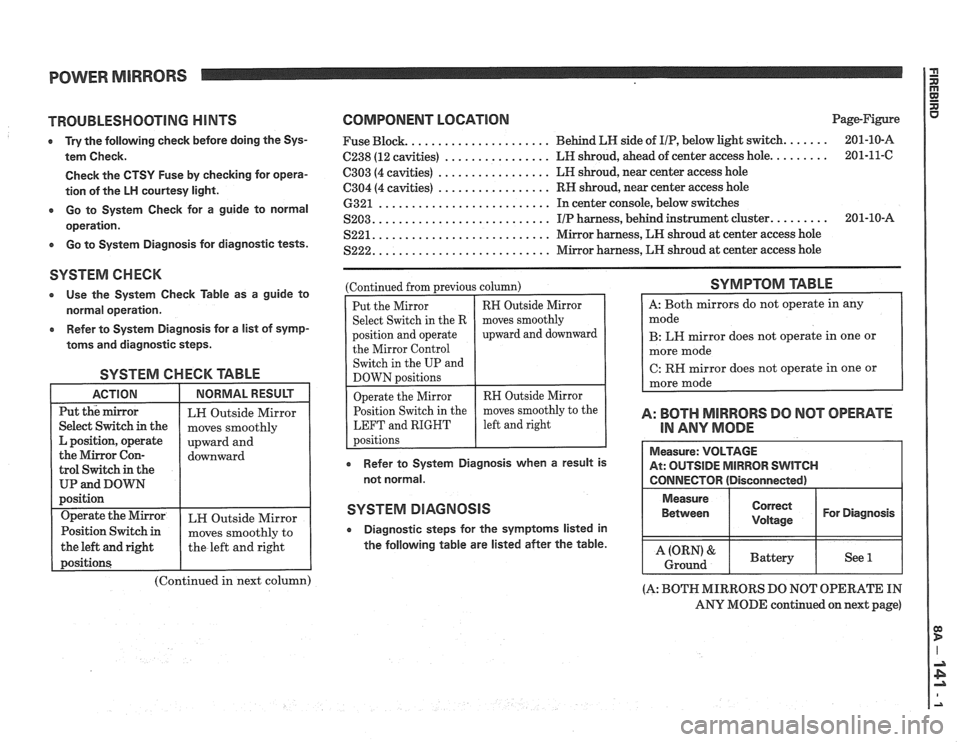
POWER MIRRORS
TROUBLESHOOTING HINTS
e Try the following check before doing the Sys-
tem Check.
Check the CTSY Fuse by checking for opera-
tion of the
LH courtesy light.
a Go to System Check for a guide to normal
operation.
e Go to System Diagnosis for diagnostic tests.
SYSTEM CHECK
0 Use the System Check Table as a guide to
normal operation.
e Refer to System Diagnosis for a list of symp-
toms and diagnostic steps.
SYSTEM CHECK TABLE
the left and right
(Continued in next column)
COMPONENT LOCATION Page-Figure
..................... Fuse Block. Behind
LN side of IIP, below light switch. ...... 201-10-A
C238 (12
cavities) ................ LH shroud, ahead of center access hole. ........ 201-11-C
................. C303 (4 cavities) LN
shroud, near center access hole
C304 (4 cavities) ................. RH shroud, near center access hole
.......................... 6321 In center console, below switches
.......................... S203. I/P harness, behind instrument cluster. ........ 201-10-A
S221. .......................... Mirror harness, LN shroud at center access hole
S222. .......................... Mirror harness, LN shroud at center access hole
(Continued from
~revious column)
Put the Mirror
Select Switch in the R
position and operate the Mirror Control
Switch in the UP and
DOWN
Dositions
RN Outside Mirror
moves smoothly
upward and downward
perate the Mirror RH Outside Mirror
osition Switch in the moves
smoothly to the
LEFT and RIGHT
e Refer to System Diagnosis when a result is
not normal.
SYSTEM DIAGNOSIS
a Diagnostic steps for the symptoms listed in
the following table are listed after the table.
SYMPTOM TABLE
B: LW mirror does not operate in one or
C:
RH mirror does not operate in one or
A: BOTH MIRRORS DO NOT OPERATE
IN
ANY MODE
(A: BOTH MIRRORS DO NOT OPERATE IN
ANY MODE continued on next page)